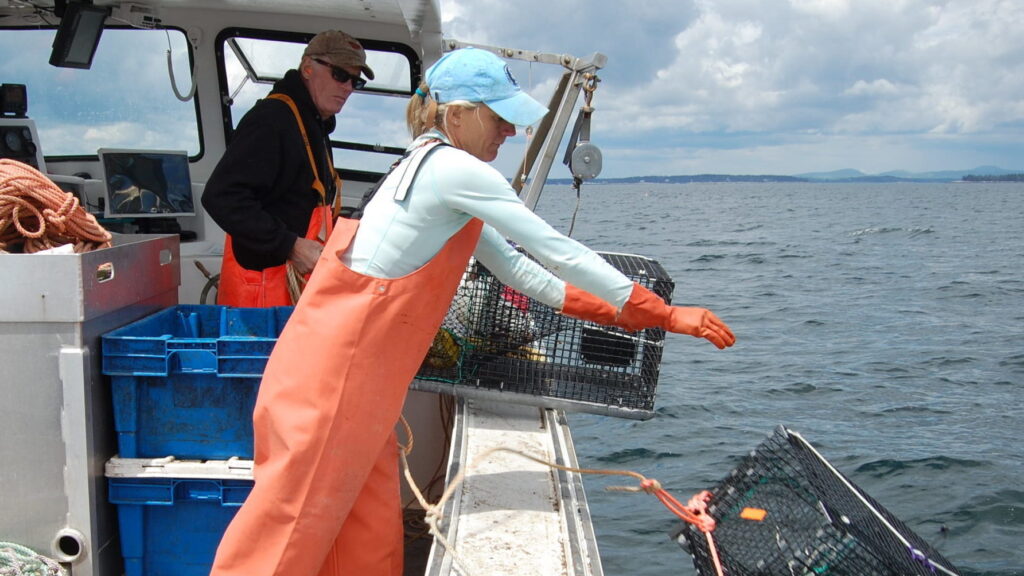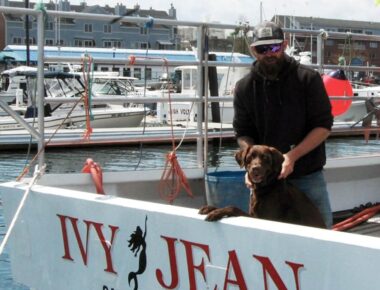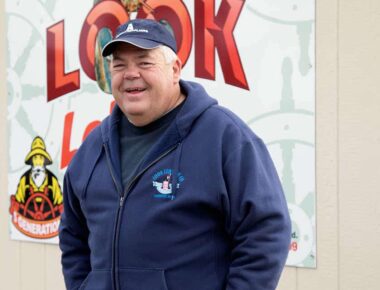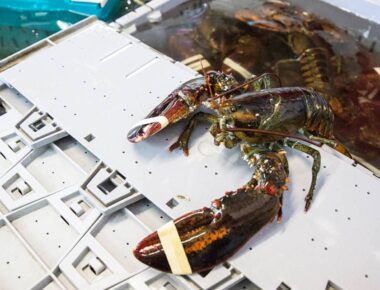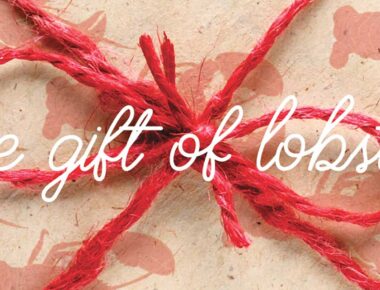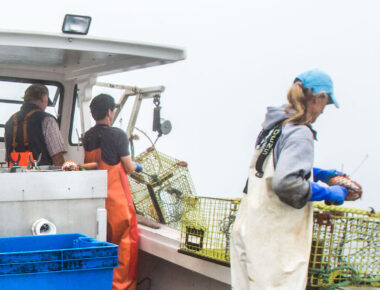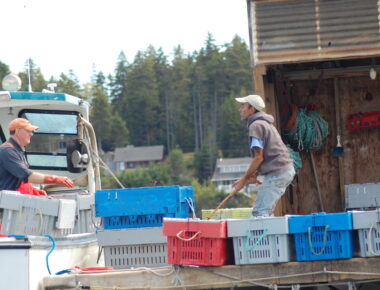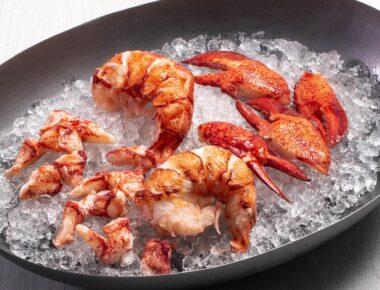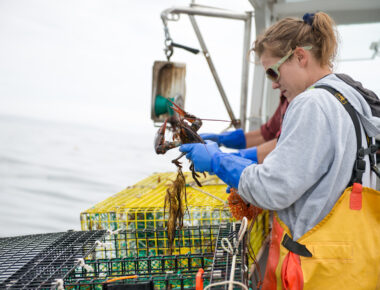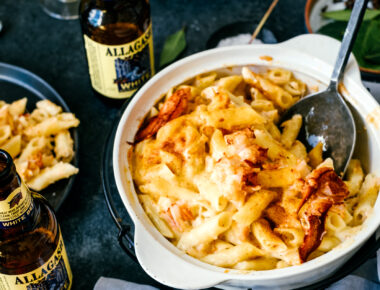The sustainability of Maine’s lobster fishery is often touted: v-notch for egg bearing females, both under and oversize restrictions, and a (very) limited entry fishery. Not surprisingly, given the lobster industry’s economic significance to Maine, the state has adopted a wide array of mechanisms not only to protect the lobster fishery, but to measure its health for the future.
In the cold winter months I got a predictably cryptic text message: “ventless trap, you want to go stern?” And so it was I found myself standing on the wharf at 4am with Peter Miller, captain of f/v SASHA, in June waiting for a Department of Marine Resources (DMR) scientist. The day before we had loaded the ventless traps aboard. The traps themselves were different, the mesh was smaller, making them difficult to maneuver (my fingers barely fit inside the mesh), and true to form, they had no vents. Just before 5am, an extremely apologetic DMR scientist, Katherine Thompson, jumped aboard (“I am so sorry, my alarm didn’t go off, this is the first time I’ve ever been late”) and we steamed out of the harbor (Peter, wry grin, “how much guff should I give her for being late?”). Soon Peter and Katherine got down to studying the DMR chart which showed where we were to set the traps.
Here’s how the ventless trap program works: each year DMR hires fishermen from different locations to participate in the program as a way to see what the lobster population is doing. DMR randomly selects a series of waypoints throughout the selected area (Western Penobscot Bay in our case) and at each waypoint the participating fishermen sets 1 triple (three traps). You set, then haul on a three night “soak”; rebait and haul again on a second three-night soak. This is done three times over the course of the summer in June, July and August, New Shell season – when the lobsters come inshore to shed. Fishermen are paid a day rate for their efforts but don’t keep any of the lobsters.
Participation in the program is something like taking a 9-5 job for independent-minded fishermen, who typically fish the weather. With the ventless program, the fishing days have to be scheduled in advance, on a Google calendar nonetheless (Peter to me: “I’m not going to frig with that damn calendar thing.”) In the end we worked out the dates together and I imported the calendar – now every time I open my work calendar I get the full overview of the ventless program all around the state (Dustin set RJH, Trevor haul KJT, the participating fishermen and the initials of the scientist who would go along).
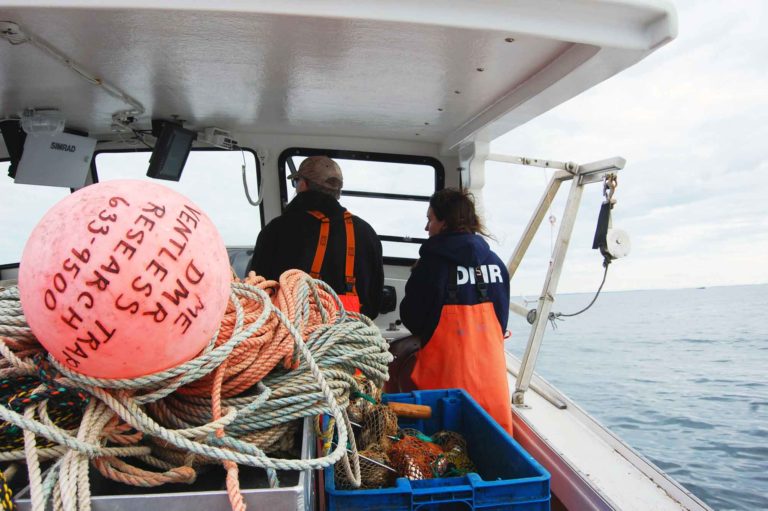
Since the waypoints were set by DMR, we would be fishing well outside the territory Tenants Harbor fishermen are “allowed” to fish (as deliniated by the unwritten boundaries passed down from generation to generation). This was one of the things I was most looking forward to, I had spent much of my childhood sailing up through the bay but had not been there much in recent years – it was, I knew, stunning with its islands and thoroughfares. We made our way around the bay that morning, as far southeast as Matinicus and Seal Island, to the East side of Vinalhaven, and down through the Mussel Ridge Channel, all as beautiful as I remembered it, setting each triple in the required location.
Three days later we were back with Katherine (arriving early this time) steaming out on the backside of an Easterly blow, a slight ground swell running (“We lucked out with the weather, I thought there would be much more of a sea”). On the steam out I chatted with Katherine. Her father had been a ground fisherman and she’d been a stern man herself (I could tell right away she knew her way around the back of a boat). She has an easy smile and the sense of humor to go with it – necessary, I knew (from experience), for any job that required jumping aboard fishing boats. But when she got down to what she was there to do, she was all business.
We hauled each trap and emptied them into three baskets, counting and recording everything: lobsters, crabs and any fish. What was in the traps was unlike anything I’d seen. Because they had no vents and the mesh was so small, the traps contained mostly baby lobsters. (Peter to me, “I nearly started throwing the undersized ones overboard, it doesn’t feel right keeping the shorts”). Some traps contained close to 50 lobsters. “Wait until the July and August haul – we’ll have upwards of 100 per trap,” Katherine related. She took each basket and, dictating into a Madonna-like headset, went through everything, recording the length of the lobster, male or female, eggs no eggs, v-notch, and any other relevant observations, all at a pace and with a fluidity I found astounding.
We wound our way through the Bay. With the long steams between several of the waypoints, there was an uncharacteristic break in the day allowing Peter and Katherine time to talk. The topics flowed easily – the increase of small lobsters offshore; rebound of groundfish populations especially flounder; how herring no longer came ashore the way they used to. I got the sense that this conversation would have continued, happily, for a good long time had we not come upon our next waypoint. Listening, I thought, data aside, this is the heart of the ventless program, the easy and rich exchange between scientists and fishermen in a place where fishermen are most comfortable, with an expanse of sea around them, where their infinite knowledge and expertise comes easily, intuitively.
We steamed in after our day of hauling, bypassing the buy float, usually the last stop on any haul day – this trip was for science, not profit. When we got to the dock Katherine hopped on the dock. “You won’t see me Saturday, it’ll be Mike coming along with you to haul. You’ll like him, he’s great. And he’ll be on time!” Quick smile and off she went, her bag of science tools and Grundens in hand.



